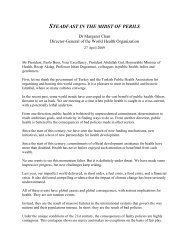The Evolution of HTA in Emerging Markets Health-Care ... - TREE
The Evolution of HTA in Emerging Markets Health-Care ... - TREE
The Evolution of HTA in Emerging Markets Health-Care ... - TREE
You also want an ePaper? Increase the reach of your titles
YUMPU automatically turns print PDFs into web optimized ePapers that Google loves.
OHE Consult<strong>in</strong>g Report for PhRMA<br />
5 January 2011<br />
Resource generation: This covers skill and technology development, recognis<strong>in</strong>g that healthcare<br />
providers need medical <strong>in</strong>puts <strong>in</strong> terms <strong>of</strong> skilled tra<strong>in</strong>ed labour and relevant technologies for the<br />
production <strong>of</strong> medical care.<br />
5.4 Functions and goals <strong>of</strong> health systems<br />
Gottret and Scheiber (2006) report a framework that was put forward by WHO (see also WHO [2000,<br />
2003]) and is consistent with Figure 2 above. That is a categorization <strong>of</strong> health systems accord<strong>in</strong>g to<br />
the four pr<strong>in</strong>cipal functions <strong>of</strong> stewardship, resource creation, service delivery and f<strong>in</strong>anc<strong>in</strong>g and the<br />
three pr<strong>in</strong>cipal objectives, i.e., health, fair f<strong>in</strong>ancial contributions and responsiveness to non-‐medical<br />
expectations (Figure 3).<br />
Figure 3: Functions and goals <strong>of</strong> health systems: Gottret and Scheiber (2006)<br />
Accord<strong>in</strong>g to these frameworks, the observed variation <strong>in</strong> the structure and organization <strong>of</strong> health<br />
systems depends on how the various functions and its components (especially f<strong>in</strong>anc<strong>in</strong>g, provision<br />
and stewardship functions) have been <strong>in</strong>tegrated or segmented, vertically or horizontally. This level<br />
<strong>of</strong> <strong>in</strong>tegration could be partial or complete. In this regard the framework itself is consistent with the<br />
paradigm <strong>of</strong> purchaser provider split.<br />
5.5 A 3-‐model typology <strong>of</strong> health systems<br />
Our conclusions about significant differences <strong>in</strong> how healthcare systems are categorized was noted<br />
by Lee, et al. (2008) work <strong>in</strong> which they identified a 3-‐model typology (<strong>in</strong>to National <strong>Health</strong> System<br />
[NHS], Social <strong>Health</strong> Insurance [SHI] and Private <strong>Health</strong> Insurance [PHI]) as the most common and<br />
well known. <strong>The</strong>y document previous typologies dat<strong>in</strong>g back to work done <strong>in</strong> 1973. Lee, et al. (2008),<br />
however, develop their own framework for assess<strong>in</strong>g the nature <strong>of</strong> the healthcare systems. <strong>The</strong><br />
27








